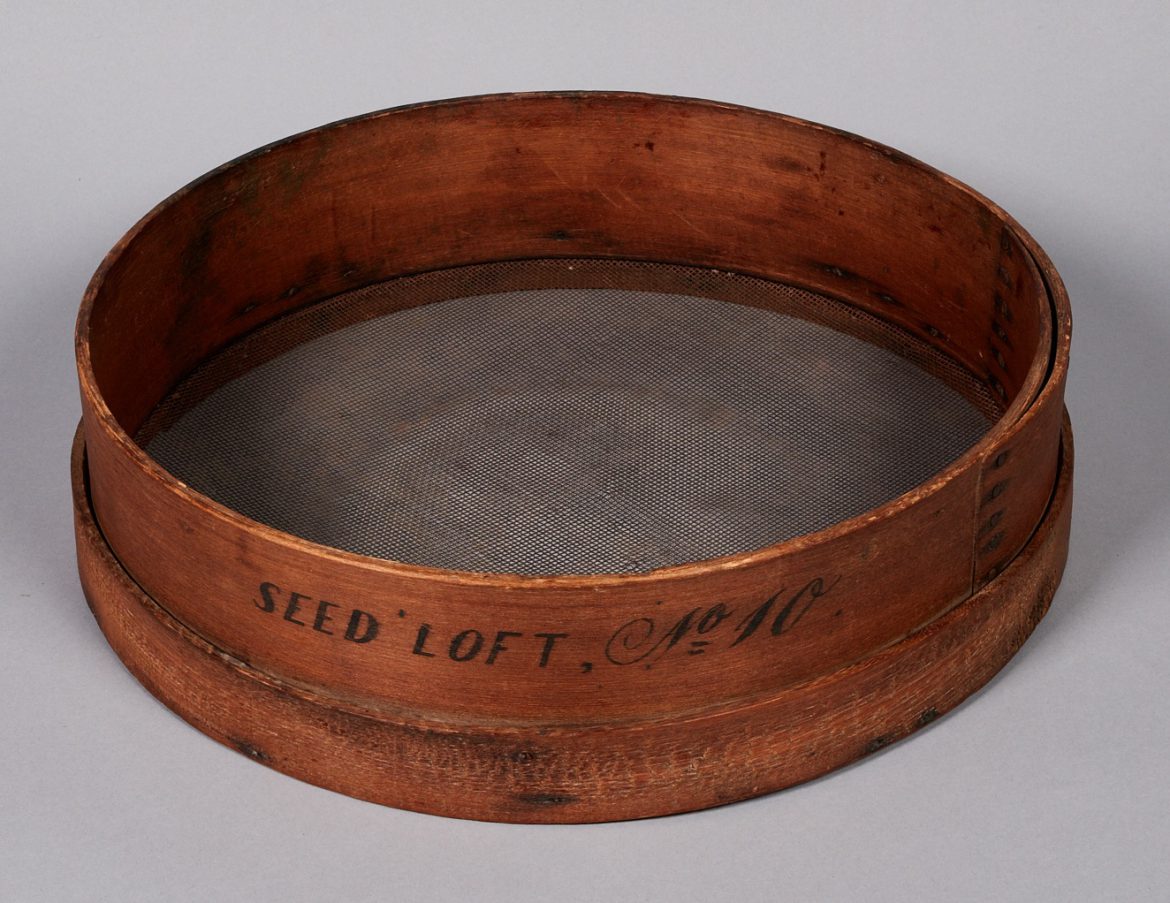
Seed Loft Sieve, North Family, Mount Lebanon, NY, Ca. 1840, Shaker Museum | Mount Lebanon: 1962/13809.1. John Mulligan, photographer.
Sieves of all sizes were made, sold, and used by the Shakers at Mount Lebanon beginning as early as 1810. They were made with bentwood rims of ash, elm, and maple. The rims were fitted with a woven mesh of horsehair, iron wire, or brass wire. The size of the sieve rim and how tightly the mesh was woven […]

Seed Loft Sieve, North Family, Mount Lebanon, NY, Ca. 1840, Shaker Museum | Mount Lebanon: 1962/13809.1. John Mulligan, photographer.
Sieves of all sizes were made, sold, and used by the Shakers at Mount Lebanon beginning as early as 1810. They were made with bentwood rims of ash, elm, and maple. The rims were fitted with a woven mesh of horsehair, iron wire, or brass wire. The size of the sieve rim and how tightly the mesh was woven determined how the sieve was intended to be used. Intent, as with many other tools, is frequently violated and sieves should probably be seen, like screwdrivers, as multi-purpose tools. For example, sieves intended to clean wheat could have just as easily been used to screen the dust from charcoal at a blacksmith’s forge. The sieve featured here, however, was assigned a particular use. It is clearly marked, “Seed Loft No. 10,” indicating it was very likely used in the Seed Loft of the Brick Shop at Mount Lebanon. In a 1931 photograph of the northwest room on the second floor of the shop, several sieves are shown hanging from peg rail. Although the numeral “10” written on the side of the sieve suggests the Shakers had a large number of sieves, the number probably refers to the size of the woven mesh mounted in the sieve and therefore indicates the related size of seeds that could be cleaned with that sieve. The sieve has a mesh woven with ten wires to the inch. Although there are a number of standards used to describe the size of openings in woven wire (or hair) screening, some taking into account the thickness of the wire and the size of the opening between the wires, in the 19th century the number of wires per inch was a common way of describing woven screen – for example, a sieve with a 4-mesh might be appropriate for cleaning corn seed or beans, a sieve with a 32-mesh would be more appropriate for cleaning mustard seed.

Seed Loft, Brick Shop, North Family, Mount Lebanon, NY, 1931, Historic American Buildings Survey, Charles C. Adams, photographer. Retrieved from: http://www.loc.gov/pictures/item/ny0109.photos.115496p/resource/
Sieves were used to remove unwanted materials – chaff, dirt, weed seeds, bugs, mouse droppings, etc. – prior to seed being stored or packaged. In the cleaning of seed, sieves were used in two different ways. Starting with a sieve with a mesh larger than the size of the seed being cleaned, the seed was poured into the sieve. The sieve was rotated – some say an elliptical motion is best – and occasionally given a shake to let the seed drop through to a container while larger pieces of stalk and seed pods remain behind. Once the larger materials are removed a sieve with a mesh smaller than the seed being cleaned is used. The seed is poured into this sieve and it is again rotated and shaken, but this time the detritus falls through the mesh leaving the clean seed ready for final inspection and packaging.
An undated publication in the Museum’s collection titled, Annual Wholesale Herbalist’s Catalogue of Medicinal Plants, and Botanical Remedies, issued by A. Warner of New York City, includes several pages of offerings of “Garden Seeds, … Raised by the United Society of Shakers,” to which is appended an offering of “Shakers’ Sieves.” The variety of sieves made and sold by the Shakers listed here provides insight into the uses of other sieves in the Shaker Museum collection.

“Shakers’ Sieves,” Annual Wholesale Herbalist’s Catalogue of Medicinal Plants, and Botanical Remedies, sold by A. Warner, Wholesale Herbalist, No. 112 John Street, New York, ca. 1850s, Shaker Museum | Mount Lebanon: 1982.19231.1